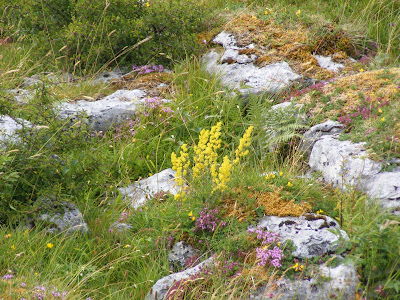Here's some great news! This week we will be filming a "how to install MeadowMat" video for the new MeadowMat website. If you drop me an e-mail I'll let you know when it's been edited and published
 |
| Cattle relaxing in a traditionally managed meadow. Don't like the look of the horns on that one! |
It's been a while since I took a wander around the traditionally managed meadow where I took so many pictures of cowslips earlier in the year. The meadow is still there, still beautifully floral but, unfortunately for my camera and I, currently being grazed. This year, the spring was so dry and grazing so hard to come by that the cows were put on to the field earlier than usual. I'm not normally deterred by cattle, but these ones have big horns and baby calves so I'm biding my time until the farmer can come with me to calm the beasts while I take snapshots......these Mammas can be very protective of their babies and as this field is two miles from the nearest road, it would be a big risk to take for the sake of a pretty picture or two.
This isn't a brilliant picture. You can't see just how many different species are actually flowering in the meadow at the moment. Sadly that's in contrast to the farmland around it. I'm married to a farmer and I'm a farmer's Mum so I'm not about to criticise our food producers but now that many of the hedgerow flowers have finished blooming and started to set seed (yum! that means blackberries), there are very few sources of nectar for our bees to be feeding on. If it weren't for the cow meadow (and remember that upwards of 95% of these meadows have disappeared since the second world war) there would be some pretty hungry bees along kettle lane right now.
The Telegraph last weekend had a couple of wonderful articles on supporting garden bees. I'm glad our garden writers are spreading the word. I really do think that the survival of our pollinators can be helped by gardeners and green roofers planting nectar rich flowers that bloom in late summer and autumn .
 |
| Foxgloves in Thetford Forest June 2010 |
 |
| Wild Flowers on The Burren in County Clare. Seemingly infertile unmanageable land brings forth the most amazing floral display |
1 comment:
I really liked the article, and the very cool blog
Post a Comment